 |
| This is an abbreviated version of 11 months of laboratory observations of my loko wai (freshwater pond). You should include all of your observations: how organisms move, how they interact, their colors, anatomic structures you observed, feeding behavior, etc. How did you identify an organism? Day 0 (June 13). Set up with water and sediment from a hillside spring. Two floating duckweed plants (Spirodela polyrhiza) on top. One annelid was visible in the sediment with 10x (dissecting scope). A piece of watercress is floating midway. One rotifer on watercress stem.  Day 4. Replaced 3 ml evaporation with distilled water. One nematode visible at 100x. Anabaena (cyanobacteria) are the most abundant photosynthesizers. Nitrogen-fixing heterocysts are clearly visible in the filaments (inverted scope, 400x). One Scenedesmus visible.  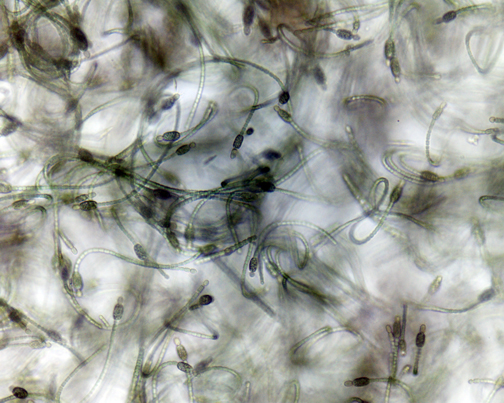 Day 5. Scenedesmus, diatoms and cyanobacteria visible. Paramecium-like ciliate: TMTC 5 rotifers seen. (Inverted microscope, 100x). 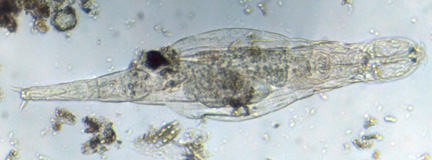 Day 7. Added 2 ml distilled water to replace evaporation. 25 rotifers, most attached to bottom substrate, actively feeding. One Vorticella. It was feeding by expanding and contracting its coiled stalk (inverted scope, 400x). One moving aquatic non-parasitic mite (35x). These are common in healthy ecosystems. They usually go unnoticed, as they stay hidden in the sediment. 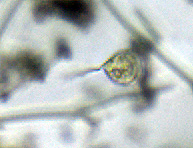 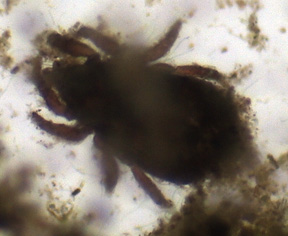 Day 8. Added 3 ml distilled water. All observations with inverted microscope, 400x. 1 ameba actively moving by pseudopods. 1 Vorticella actively feedings. 20 Scenedesmus. 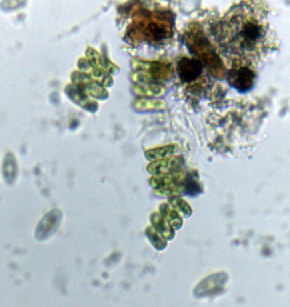 Motile, large Paramecium (TMTC) and fewer hypotrich ciliates now present. (Can't find the mite.) Nassula (ciliate) mating. 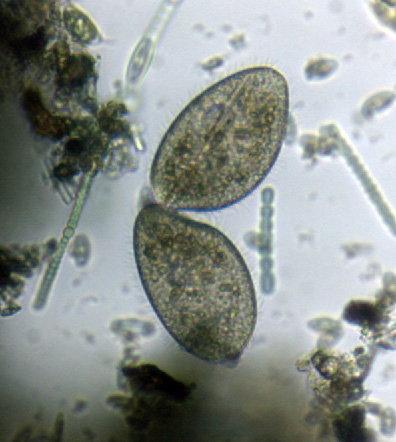 Day 9. Replaced 2 ml water. Rotifers have green food visible in their guts. Diatoms are the predominant photosynthesizers. Gophonema diatoms are dividing: daughter cells still attached at branched mucilaginous stalk. 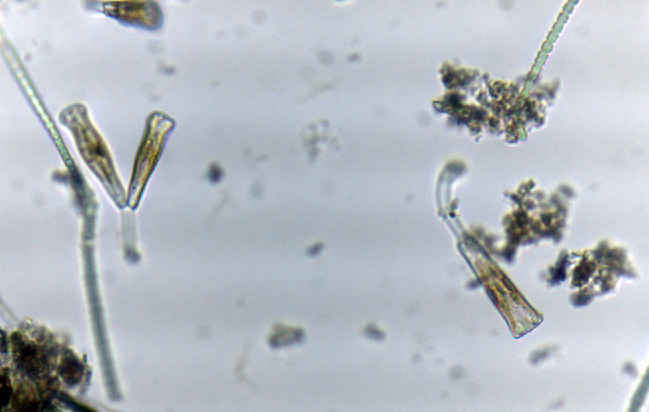 Day 12. Added 2 ml water. Rotifers are still abundant: paired cilia around the mouth are easily seen. The rotifers have golden-brown (diatoms) in their guts now. 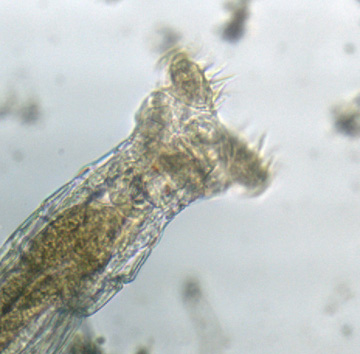 One unbranched filamentous green algae (eukaryotic) present. Ameba are now readily visible (N ~10). The photos are one ameba moving through organic matter. 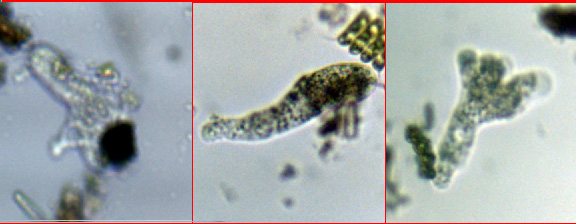 Day 14. Many Paramecium. Ostracods in the mud. They look like little white seeds but their moving legs are visible using the inverted scope (100x-400x). 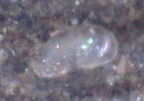 Day 19. Fewer algae and cyanobacteria: One Closterium; Scenedesmus, Gophonema, Anabaena. Many Paramecium and rotifers. Added 0.01 g protozoa food (Carolina). Replaced 3 ml evaporation 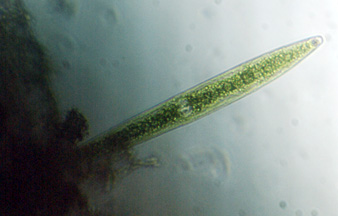 Ostracods clearly visible moving up to feed at the sediment-water interface. Note the open valves and (moving) legs used in filter-feeding. 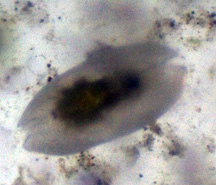 Day 20. Rotifers everywhere: at least 30 in every field. TMTC Paramecium. Ostracods feeding in the water column. One copepod. Day 22. One copepod. 10 Vorticella. TMTC Paramecium. 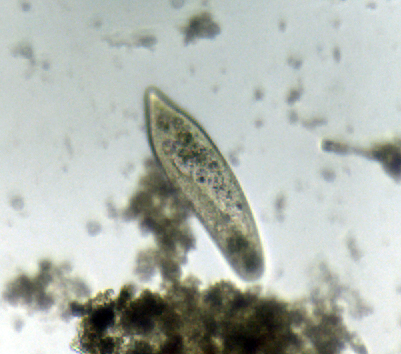 TMTC rotifers. Hundreds of rotifer eggs on algae and debris. Rotifers are parthenogenic. 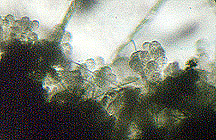 Day 23. One white amphipod. Day 26. Ostracods are actively feeding in water column and rotifers are abundant. GiantMicrobes.com calls rotifers the 'Little Princesses.' Tunnels in mud are visible with stereo scope and light from above. Wonder who's making the tunnels? (Ostracods are making the tunnels.) Day 27. I want that copepod to do a little population control on the rotifers! Day 33. Spirogyra is the predeminant algae. Spirogyra is a filamentous green alga. Note the cross walls separating cells in a filament (blue arrows). Note the spiral chloroplasts in filament A. Spirogyra B and C are mating: see the conjugation tubes between each cell in the filaments (pink arrow). During conjugation, the contents of the cells in C moved to the cells in B forming a zygote (green arrow) in each cell in B. 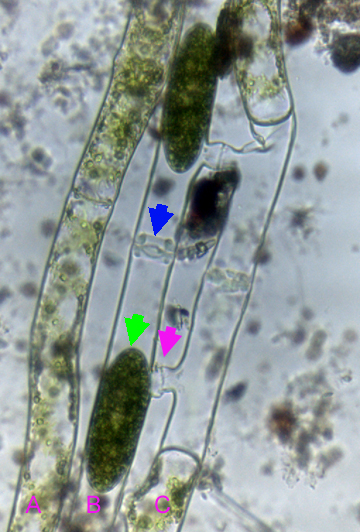 Also seen today: three Euglena. Day 35. One each: ameba, Vorticella, Euglena. Several large Paramecium. Two nematodes. Nematodes moving by thrashing (see the photos of one nematode below). The longitudinal muscles contact producing undulations of the body. They don't have circular muscles, therefore they can't elongate the body.  Day 40. Several Euglena gliding around. 3 copepods; 2 copepod larvae; 1 large (3-4 mm) green ostracod. All of these animals moved quickly. Note the single red eye: This is a cyclopoid copepod. 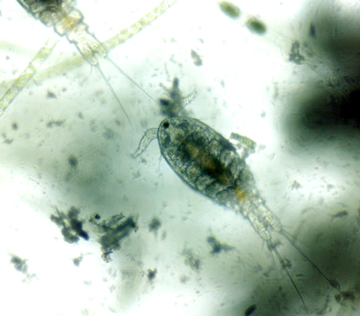 Added 0.01 g protozoa food (Carolina). Day 41. Predominant producers are Gomphonema and a nonmotile, unicellular green alga (Chlorella?).  Copepod nauplius larvae are plentiful. These are cyclopoid copepods (see the single red eye, 'cyclops', in the photo). 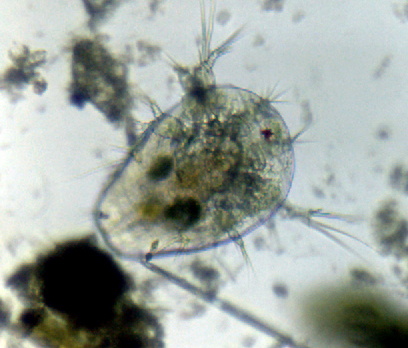 Rotifers are still plentiful: 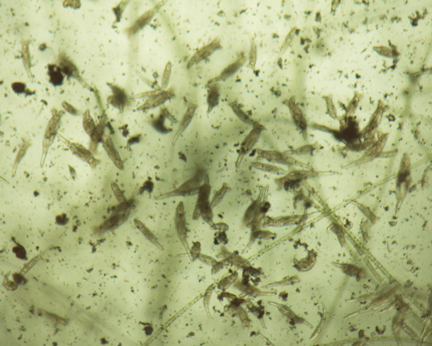 Observed the large green ostracod come out of the mud, swim around feeding ~30 min, and return to the mud. Day 42. Rotifers are plentiful in the mud but not in the water column. Copepod adults and larvae are numerous. Chlorella and Spirogyra. Day 43. Few copepods and a dozen rotifers. Empty copepod skeletons seen. Vorticella, Euglena, Spirogyra, Gomphonema, Scenedesmus, Chroococcus (below).  Shelled (testate) ameba are numerous (Difflugia). Right pic shows test (shell) detail; left pic show a pseudopod being extended. These shelled ameba (Euglyphida) are predatory on other ameba. (http://istar.wikidot.com/id-keys)  Day 47. ~100 testate ameba. 2 Vorticella. ~25 rotifers. ~25 copepods, including nauplius larvae and adults with eggs sacs. Nothing was visible (inverted scope) in the water column except for the algae, Vorticella, and ameba. Ostracods and copepods were visible in the mud using the stero scope with lighting from above. Added 0.01 g protozoa pellets, which created a feeding frenzy: rotifers, copepods, ostracods (including Big Green) came out of the mud. Adult females are moving too fast…maybe I'll get a better picture later.  Day 50. No rotifers visible! Copepod adults and larvae, Difflugia, and Vorticella attached to the walls. And the big green ostracod is still cruising. Copepod larva attacked a Difflugia pseudopod. It stayed on the pseudopod looking like its jaws were moving. When the copepod backed away, the formerly healthy moving pseudopod was shriveled. 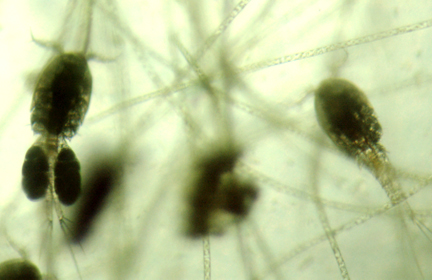 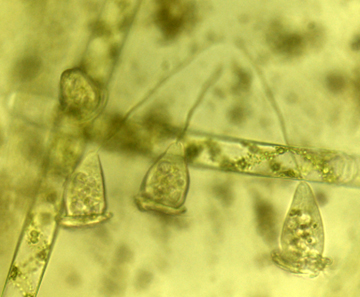 Algae: Spirogyra, Anabaena, Gomphonema, Chlorella, Scenedesmus. Day 53. Several small white ostracods + 'big green' out feeding. Numerous copepods (larvae, adults, females with egg sacs), Vorticella, Difflugia, one rotifer. Mating copepods: 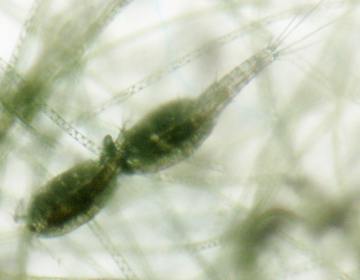 Day 55. Several Euglena were in the mix today. Added 0.01 protozoa food. Day 57. Abundant copepods (mating, females with eggs, larvae). Abundant Vorticella and small white ostracods (+ big green). 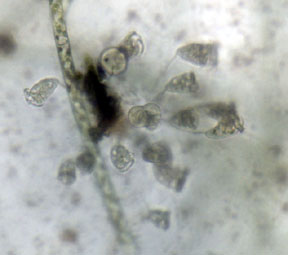 Day 61. Anabaena, Chlorella, Vorticella, and Difflugia are abundant…indicative of an aging, eutrophic ecosystem. Abundant copepods (mating, females with eggs, larvae), small white ostracods (+ big green). Day 65. Ostracods are getting big and numerous. Day 69. Anabaena is abundant. Small patch of Cladophora is present. 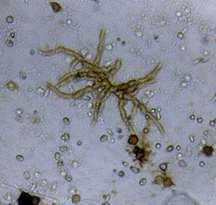 Filaments of Oedogonium present; note the basal cell on the filament is a holdfast. 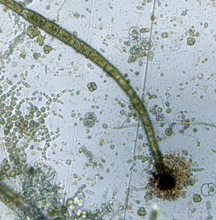 Day 71. Added 0.01 g protozoa pellets. Large, green ostracods and Vorticella predominate. Day 75. The left pix is the original set-up (from day 0). Note the accumulation of organic matter and bacterial bodies (green arrows). Copepod and ostracod carapaces from dead(?) or growing (shed) are also in the sediment. The blue arrows are large green ostracods. The red arrows show the piece of watercress.  Day 79. 25 ostracods in water, visible to eye. Cladophora acculumulating on aquarium walls. Day 84. Unicellular green alga (Dunaliella?) starting to cover the walls. Ostracods are abundant, a few copepods visible in mud.  Day 90. Ostracods and copepods are going strong. The aquarium is almost 2/3 full with detritus. Day 100.  The left pic is from day 1, right pic is today. Chlorella is accumulating on the walls and detritus is filling the bottom. Ostracods are visible in the water. The left pic is from day 1, right pic is today. Chlorella is accumulating on the walls and detritus is filling the bottom. Ostracods are visible in the water. 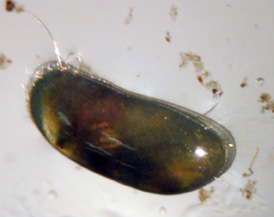 Day 142. Abundant ostracods and copepods in water column and in mud. These eggs in mud, most are in cluster. Nematode eggs??? Eggs viewed with dissecting scope. 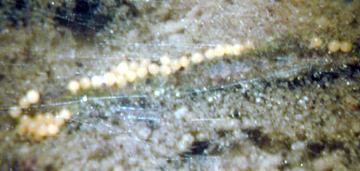 Day 153. Protozoan that moves like a flagellate in water column—difficult to see through the Chlorella. Copepods and seed shrimp (small white ostracods) in mud. Those little white balls could be an early seed shrimp instar????? Day 157. Removed some mud for microscopic examination using upright scope: Scenedesmus, diatoms, nematodes, copepods with eggs, ciliates. Large ciliate, Blepharisma? At 1000x numerous bacilli, a few spirilla. Day 182. Ostracods, copepods still going strong. Hatched (nematode?) eggs on walls; note the open operculum in picture. 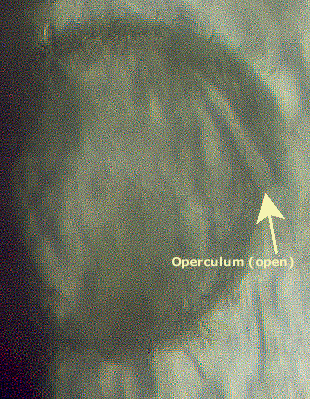 Day 282. 9 months and 9 days later: ostracods are going strong. A few copepods and this freshwater amphipod.  I dredged the detritus that was threatening to fill the aquarium. Day 331. Ostracods and small copepods. |